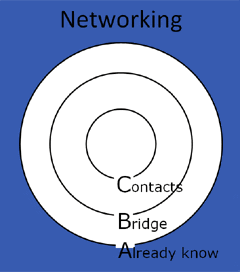“Wait,” you’re saying. “That’s not what I’ve heard. Networking is the only way to find leads for sales, jobs, and life in general.” Yes and no. Not all networking strategies are created equal, and some can hurt your brand for the long term.
The networking “strategy” of “volume” doesn’t build value if people don’t remember who you are when you contact them. Being a promiscuous networker who collects cards without relationships is a dead end.
Help others first
Having a core network of a diverse cross-section of people that you continue to help over time is the strategy that works, however. It grows your brand and the richness of your life, too. When you need help, they’ll be there for you as you’ve been there for them. Approaching them in the right order with the right message results in the outcomes you’re seeking because you’ve been putting deposits in the bank the whole time.
Hey, if this works for my landing 50 yard line Superbowl tickets at face value, think of what it can do for a job search. Piece of cake. Maybe you’ll go for tickets, too.
Slow down
The dangerous part of networking is acting on your first impulse. Let’s say that you’ve just been laid off…not uncommon these days. What I see people doing all of the time is running to their best shots first, their connections who are highly placed within organizations and may have the authority to hire them, then spilling their guts. “I can’t believe they did this! How can they put me on the streets now? I actually had relationships with important customers and we were right in the middle of a product introduction. What are they thinking??”
Your friend/ potential employer doesn’t have a clue. Maybe you aren’t as good as she thought you were if your company didn’t protect you. Maybe you’re working for a company that’s a loser. Maybe she isn’t comfortable with your public display of emotion. Who knows what’s going through her mind, but it’s rarely positive and it isn’t, “Oh, let me hire Tom. Poor thing. We need to help him and we can just put him in sales until we figure out how to get the position budgeted.” Not.
You just hurt your brand. You just dumped emotion all over most influential layer of your professional network, and it’s going to take a while to reverse the impression. Networking, at least flailing, reactive networking under pressure, can be dangerous. Don’t do it.
Understand your network’s layers
Approach the “A level” first. Networking comes in three layers. The A level on the graphic is your home base and they’ll never “un-friend” you.
• A Level: The outside ring is the people you already know. These are people that you can go back to many times. You can ask them dumb questions, be undecided or unclear about what you want, pick their brains, and listen to their opinions. They’re typically your family and friends. You can safely dump that anger with them, then move on to investigating what’s hot and what’s not in various companies and industries and where there may be potential growth. They may have some ideas. These people are important; they’re your main support during job transitions, relationships, and life, so think of their needs, too.
• B Level: The middle ring is people who create a bridge for you. These people work in organizations of interest, but they aren’t in a position to make decisions about you. You need two things from B-level people: names and needs. “Who should I be talking to, and what keeps him or her up at night?” If you’re just meeting them for the first time because of a mutual friend, establish a relationship first so they’ll trust you. Anyone from the chief financial officer to the shipping and receiving clerk has opinions about how a company and its CEO are doing. Take all their input with a grain of salt, but if you build trust and try to help them as well, you may have a new, internal champion.
• C Level: The inside ring: contact. You’ve hit the decision-maker level. Now is the time to go after your best shots, either the people that you already knew that you were holding off on until you were better prepared or ones you’ve just developed “handshakes” into. When you were setting up the meetings you probably promised that you didn’t expect them to know about jobs just because you’re calling, so stay on the subjects of market research and problem solving. Now, you’re in a position to focus on their profitability and their future, a much different conversation than “Help me! Help me!”
Warning: the boundaries between the three rings are permeable. Think carefully about the order in which you want to approach people. A-level people, ones that you already know, can be C-level, or decision makers, as well. Hold off a little on contacting them. B-level people may be C-level people in disguise. Timing is everything. As you refine how to focus on them and their profitability rather than your immediate needs, you’ll end up getting what you want…maybe even Superbowl tickets.
Author:
Pam Lassiter is author of the award winning The New Job Security and Principal of Lassiter Consulting, a career coaching firm doing outplacement or internal growth programs for companies or individuals.












